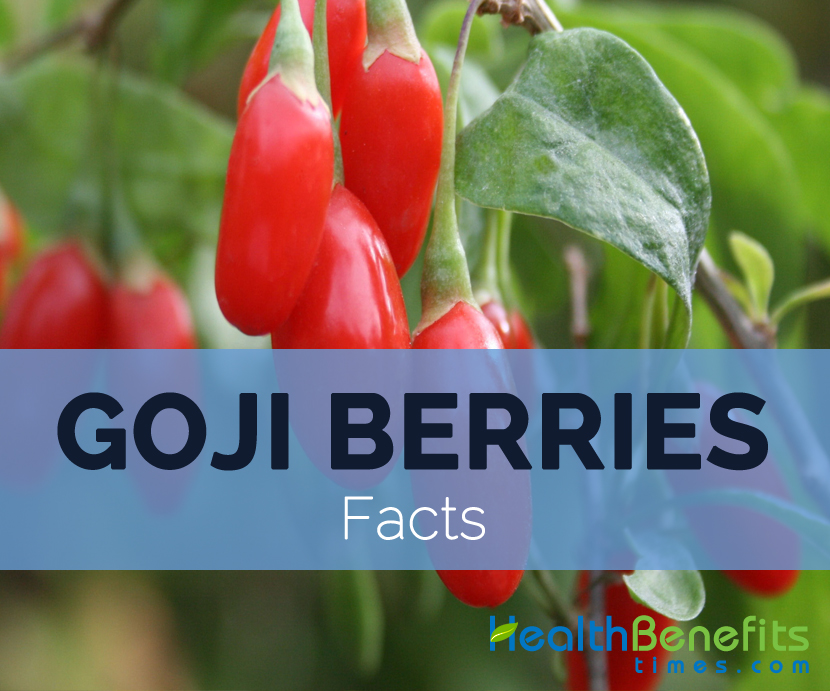 Goji berry is a medium-sized deciduous shrub with grey-green leaves, purple/blue flowers and red fruits. It resembles raisins with a nutty flavor. It is mostly found in the dried form. Goji berry possesses antioxidants, protein and vitamin C.
Goji berry is a medium-sized deciduous shrub with grey-green leaves, purple/blue flowers and red fruits. It resembles raisins with a nutty flavor. It is mostly found in the dried form. Goji berry possesses antioxidants, protein and vitamin C.
| Name | Goji berries |
|---|---|
| Scientific Name | Lycium barbarum |
| Native | Southeastern Europe and Asia. Goji was used in China and Tibet for thousands of years as a culinary ingredient and medicinally. But it was introduced in Western countries in recent years. |
| Common/English Name | Barbary Boxthorn, Box Thorn, Barbary Matrimony Vine, Chinese Teaplant, Barbary Wolfberry, Common Matrimoney-Vine, Chinese Wolfberry, Common Matrimony Vine, Goji, Duke Of Argyll’s Tea Tree, Duke Of Argyll’s Teaplant, Gojiberry, Lycium, Himalayan Goji, Red Medlar, Mede Berry, Wolfberry, Matrimony Vine and Tibetan Goji. |
| Name in Other Languages | Chinese: Di Gu Pi, Ning Xia Gou Qi; Czech: Kustovnice Obecná, Kustovnice Cizí; Danish: Almindelig Bukketorn, Bukketorn; Dutch: Boksdoorn, Goji Bessen; French: Lyciet À Feuilles D’halimus, Lyciet De Barbarie; German: Bocksdorn, Wolfsdorn; Hungarian: Ördögcérna, Semfűsemfa; Icelandic: Laufskála fl étta; India: Murali; Italian: Spina-Santa Di Barberia; Korean: Tangkugijanamu, Gu Gi Ja; Norwegian: Kinabukketorn, Bukketorn; Polish: Kolcowój Szkarłatny; Slovencina: Kustovnica Cudzia; Spanish: Mora De La Vista, Cambronera Swedish: Bredbladigt Bocktörne, Bocktörne; Tibetan: Dre Tsher Ma; Vietnamese: Cẩu Kỷ, Kỷ Tử |
| Plant Growth Habit | Deciduous, erect, perennial shrub |
| Growing Climate | Temperate |
| Soil | Moist, well-drained |
| Plant Size | 1–3 m |
| Lifespan | 4-5 years |
| Branchlets | Thorny |
| Leaf | Deciduous, grey-green, lanceolate /ovate, length: 7 cm, breadth: 3.5 cm with rounded or blunted tips |
| Edible parts of the plants | Fruit: Fruits are consumed raw, dried or fresh, processed into wine, beer, and juice or cooked. It is also added to rice congee. The fruit is used to make herbal tea. Leaves: Leaves are consumed as potherb or in the form of herbal teas. Seed: The roasted seeds are used as a substitute for coffee. |
| Flowering Season | Summer |
| Flower | Purple/blue, bell-shaped or tubular sepals which forms short, triangular lobes |
| Fruit shape & size | Ellipsoid, Diameter: 1–2 cm |
| Fruit color | Bright orange-red |
| Flesh color | Red-orange |
| Flavor/aroma | Combination of cherries, raspberries and dates |
| Fruit Taste | Mild taste |
| Seed | 10-60 tiny, yellow |
| Fruit Season | July – October |
| Major Nutritions | Vitamin A 390 µg (55.71%) Iron, Fe 1.9 mg (23.75%) Carbohydrate 21.58 g (16.60%) Vitamin C (Ascorbic acid) 13.6 mg (15.11%) Total dietary Fiber 3.6 g (9.47%) Protein 3.99 g (7.98%) Threonine 0.1 g (5.68%) Sodium, Na 83 mg (5.53%) Calcium, Ca 53 mg (5.30%) Isoleucine 0.073 g (4.37%) Valine 0.088 g (4.17%) Histidine 0.044 g (3.57%) Leucine 0.128 g (3.46%) Lysine 0.065 g (1.94%) Total Fat (lipid) 0.11 g (0.31%) |
| Health Benefits |
|
| Calories in 28 gm | 98 Kcal. |
| Traditional uses |
|
| Precautions |
|
| How to Eat |
|
| Other Facts |
|
Goji berries (Lycium barbarum)Scientific Classification
| Scientific name | Lycium barbarum |
|---|---|
| Kingdom | Plantae |
| Subkingdom | Tracheobionta |
| Order | Solanales |
| Family | Solanaceae |
| Genus | Lycium L. |
| Species | Lycium barbarum L. |
| Super division | Spermatophyta |
| Division | Magnoliophyta |
| Class | Magnoliopsida |
| Sub Class | Asteridae |

